CHCECE003 Assessment: Provide Care for Children - All Assessment Tasks
VerifiedAdded on 2023/01/09
|25
|7496
|95
Homework Assignment
AI Summary
This document contains the assessment solutions for the CHCECE003 unit, focusing on providing care for children. It includes answers to short questions, case studies, and research activities related to topics like supervision during mealtimes, sun-smart policies, the National Quality Standard (NQS) element 2.2.2 on physical activity, benefits of physical activity, activities for preschoolers, and risky play. The document also addresses topics like educators engaging with children, SunSmart policy objectives, and the benefits of risk-taking. It provides detailed responses to the questions, referencing relevant sources and policies to demonstrate understanding of the unit's key concepts and requirements. This resource is designed to assist students in completing their assessment tasks successfully.
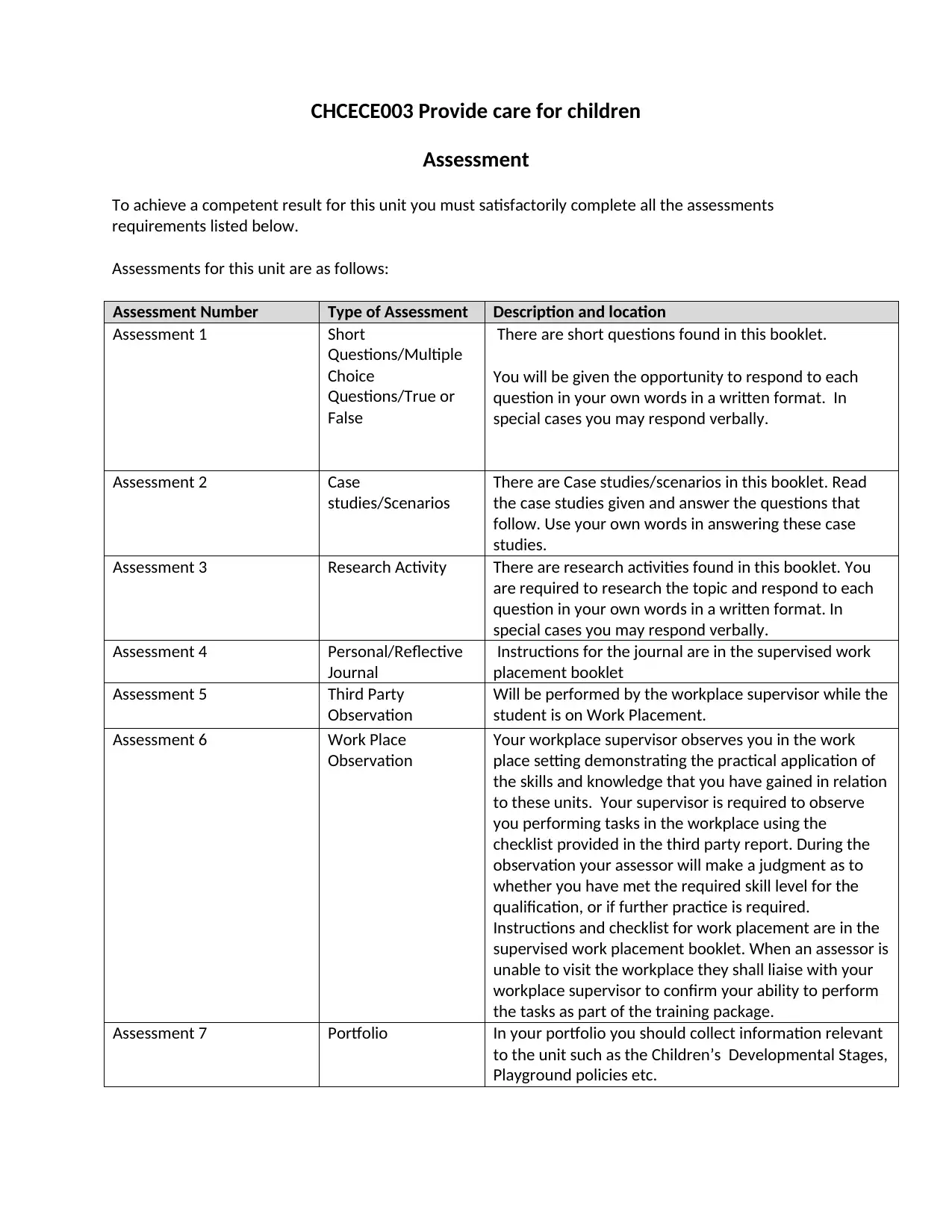
CHCECE003 Provide care for children
Assessment
To achieve a competent result for this unit you must satisfactorily complete all the assessments
requirements listed below.
Assessments for this unit are as follows:
Assessment Number Type of Assessment Description and location
Assessment 1 Short
Questions/Multiple
Choice
Questions/True or
False
There are short questions found in this booklet.
You will be given the opportunity to respond to each
question in your own words in a written format. In
special cases you may respond verbally.
Assessment 2 Case
studies/Scenarios
There are Case studies/scenarios in this booklet. Read
the case studies given and answer the questions that
follow. Use your own words in answering these case
studies.
Assessment 3 Research Activity There are research activities found in this booklet. You
are required to research the topic and respond to each
question in your own words in a written format. In
special cases you may respond verbally.
Assessment 4 Personal/Reflective
Journal
Instructions for the journal are in the supervised work
placement booklet
Assessment 5 Third Party
Observation
Will be performed by the workplace supervisor while the
student is on Work Placement.
Assessment 6 Work Place
Observation
Your workplace supervisor observes you in the work
place setting demonstrating the practical application of
the skills and knowledge that you have gained in relation
to these units. Your supervisor is required to observe
you performing tasks in the workplace using the
checklist provided in the third party report. During the
observation your assessor will make a judgment as to
whether you have met the required skill level for the
qualification, or if further practice is required.
Instructions and checklist for work placement are in the
supervised work placement booklet. When an assessor is
unable to visit the workplace they shall liaise with your
workplace supervisor to confirm your ability to perform
the tasks as part of the training package.
Assessment 7 Portfolio In your portfolio you should collect information relevant
to the unit such as the Children’s Developmental Stages,
Playground policies etc.
Assessment
To achieve a competent result for this unit you must satisfactorily complete all the assessments
requirements listed below.
Assessments for this unit are as follows:
Assessment Number Type of Assessment Description and location
Assessment 1 Short
Questions/Multiple
Choice
Questions/True or
False
There are short questions found in this booklet.
You will be given the opportunity to respond to each
question in your own words in a written format. In
special cases you may respond verbally.
Assessment 2 Case
studies/Scenarios
There are Case studies/scenarios in this booklet. Read
the case studies given and answer the questions that
follow. Use your own words in answering these case
studies.
Assessment 3 Research Activity There are research activities found in this booklet. You
are required to research the topic and respond to each
question in your own words in a written format. In
special cases you may respond verbally.
Assessment 4 Personal/Reflective
Journal
Instructions for the journal are in the supervised work
placement booklet
Assessment 5 Third Party
Observation
Will be performed by the workplace supervisor while the
student is on Work Placement.
Assessment 6 Work Place
Observation
Your workplace supervisor observes you in the work
place setting demonstrating the practical application of
the skills and knowledge that you have gained in relation
to these units. Your supervisor is required to observe
you performing tasks in the workplace using the
checklist provided in the third party report. During the
observation your assessor will make a judgment as to
whether you have met the required skill level for the
qualification, or if further practice is required.
Instructions and checklist for work placement are in the
supervised work placement booklet. When an assessor is
unable to visit the workplace they shall liaise with your
workplace supervisor to confirm your ability to perform
the tasks as part of the training package.
Assessment 7 Portfolio In your portfolio you should collect information relevant
to the unit such as the Children’s Developmental Stages,
Playground policies etc.
Paraphrase This Document
Need a fresh take? Get an instant paraphrase of this document with our AI Paraphraser
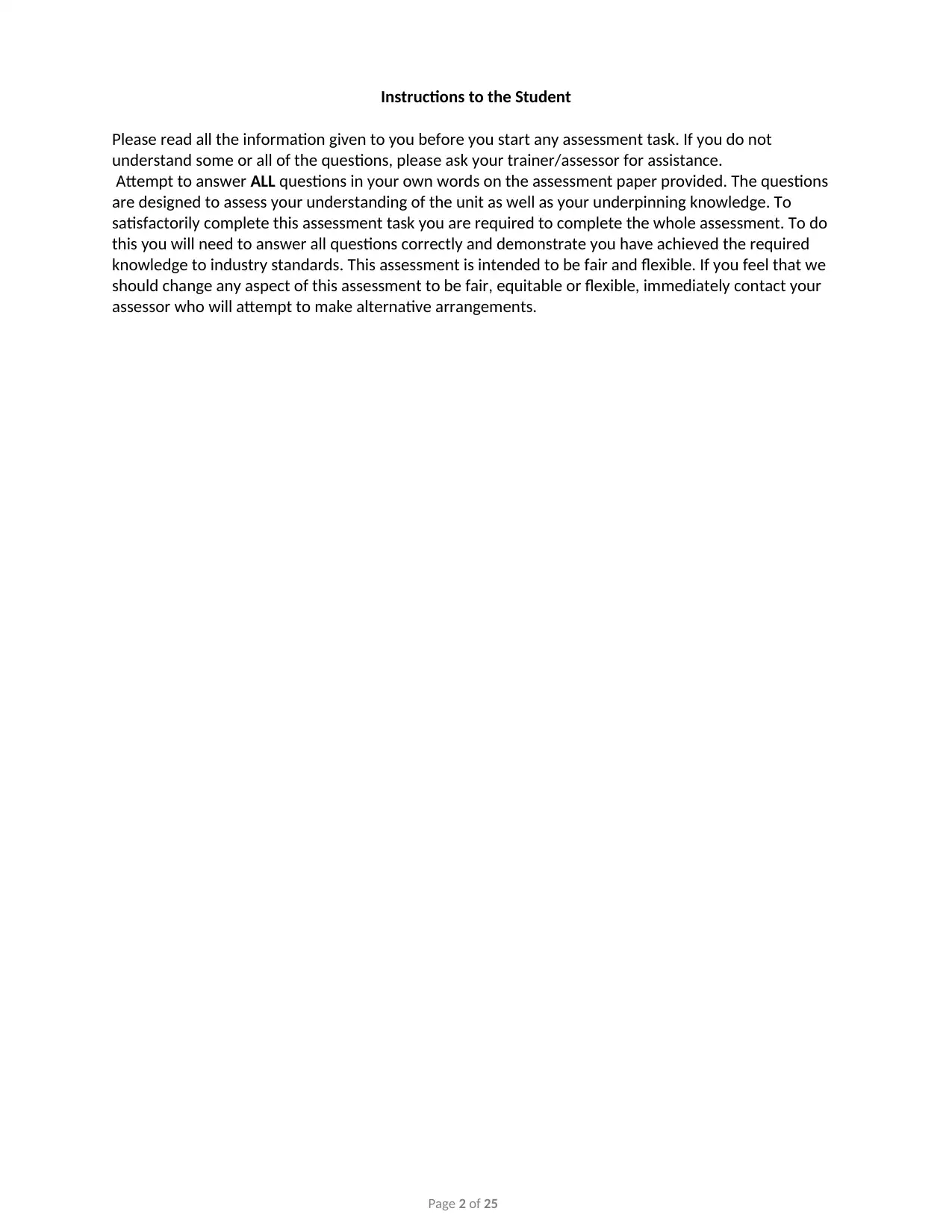
Instructions to the Student
Please read all the information given to you before you start any assessment task. If you do not
understand some or all of the questions, please ask your trainer/assessor for assistance.
Attempt to answer ALL questions in your own words on the assessment paper provided. The questions
are designed to assess your understanding of the unit as well as your underpinning knowledge. To
satisfactorily complete this assessment task you are required to complete the whole assessment. To do
this you will need to answer all questions correctly and demonstrate you have achieved the required
knowledge to industry standards. This assessment is intended to be fair and flexible. If you feel that we
should change any aspect of this assessment to be fair, equitable or flexible, immediately contact your
assessor who will attempt to make alternative arrangements.
Page 2 of 25
Please read all the information given to you before you start any assessment task. If you do not
understand some or all of the questions, please ask your trainer/assessor for assistance.
Attempt to answer ALL questions in your own words on the assessment paper provided. The questions
are designed to assess your understanding of the unit as well as your underpinning knowledge. To
satisfactorily complete this assessment task you are required to complete the whole assessment. To do
this you will need to answer all questions correctly and demonstrate you have achieved the required
knowledge to industry standards. This assessment is intended to be fair and flexible. If you feel that we
should change any aspect of this assessment to be fair, equitable or flexible, immediately contact your
assessor who will attempt to make alternative arrangements.
Page 2 of 25
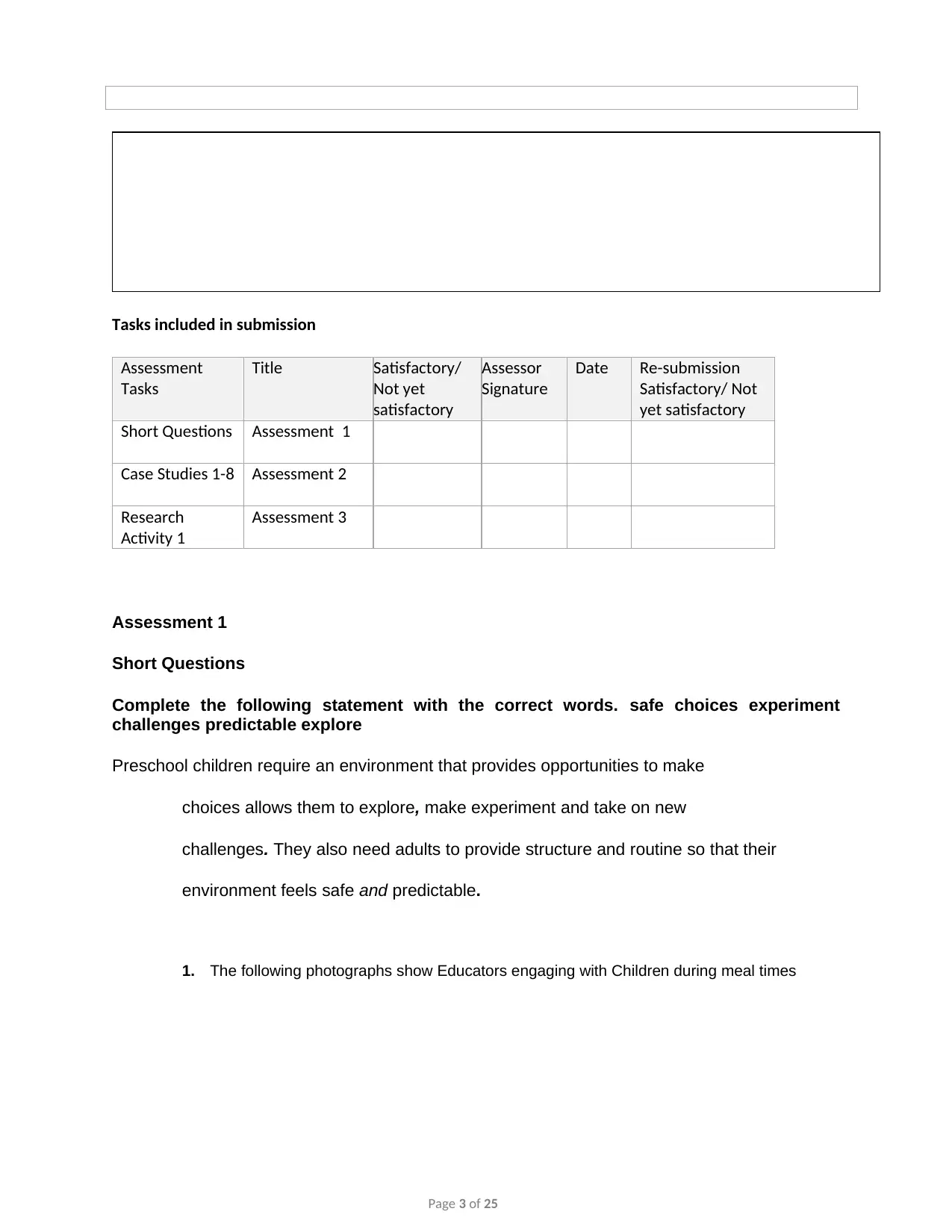
Tasks included in submission
Assessment
Tasks
Title Satisfactory/
Not yet
satisfactory
Assessor
Signature
Date Re-submission
Satisfactory/ Not
yet satisfactory
Short Questions Assessment 1
Case Studies 1-8 Assessment 2
Research
Activity 1
Assessment 3
Assessment 1
Short Questions
Complete the following statement with the correct words. safe choices experiment
challenges predictable explore
Preschool children require an environment that provides opportunities to make
choices allows them to explore, make experiment and take on new
challenges. They also need adults to provide structure and routine so that their
environment feels safe and predictable.
1. The following photographs show Educators engaging with Children during meal times
Page 3 of 25
Assessment
Tasks
Title Satisfactory/
Not yet
satisfactory
Assessor
Signature
Date Re-submission
Satisfactory/ Not
yet satisfactory
Short Questions Assessment 1
Case Studies 1-8 Assessment 2
Research
Activity 1
Assessment 3
Assessment 1
Short Questions
Complete the following statement with the correct words. safe choices experiment
challenges predictable explore
Preschool children require an environment that provides opportunities to make
choices allows them to explore, make experiment and take on new
challenges. They also need adults to provide structure and routine so that their
environment feels safe and predictable.
1. The following photographs show Educators engaging with Children during meal times
Page 3 of 25
⊘ This is a preview!⊘
Do you want full access?
Subscribe today to unlock all pages.

Trusted by 1+ million students worldwide
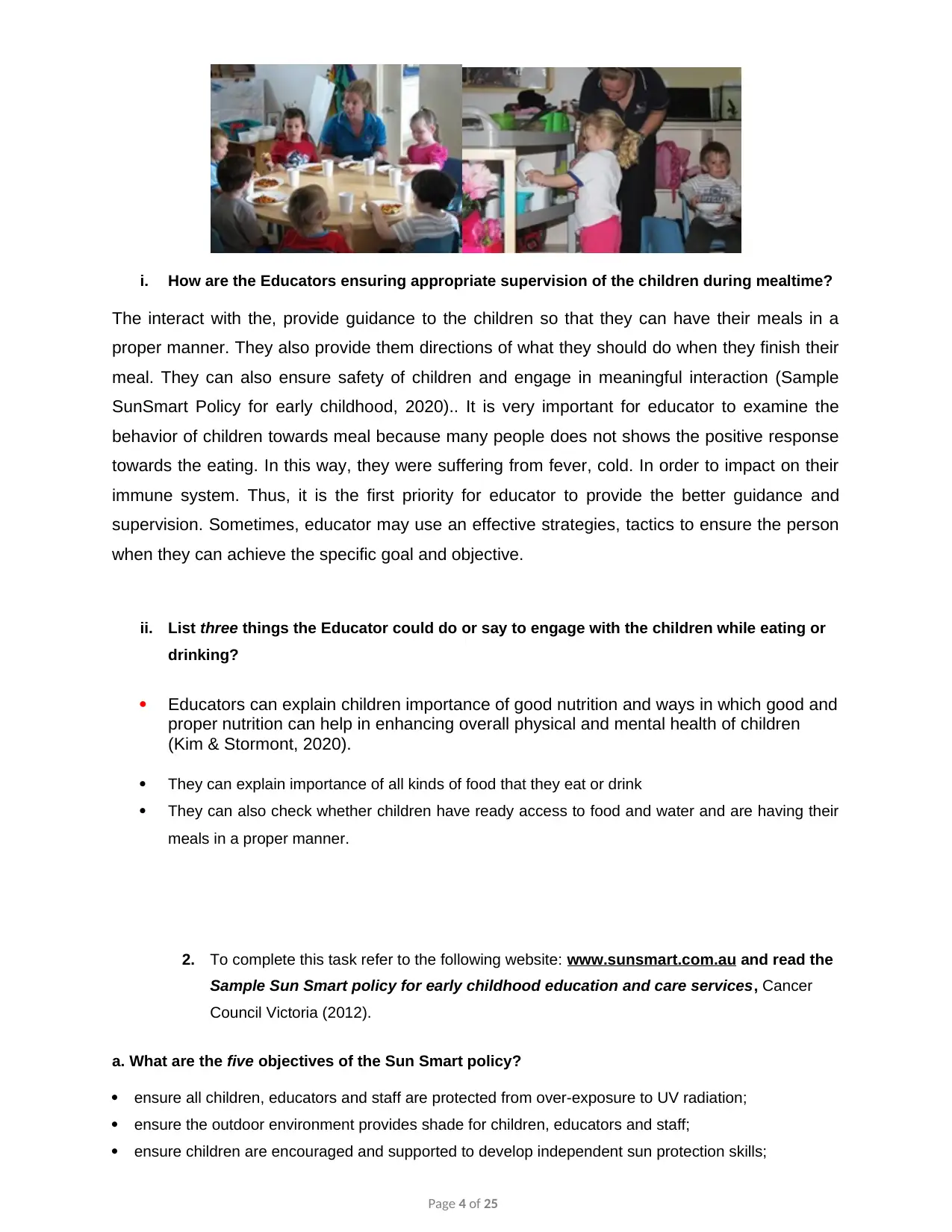
i. How are the Educators ensuring appropriate supervision of the children during mealtime?
The interact with the, provide guidance to the children so that they can have their meals in a
proper manner. They also provide them directions of what they should do when they finish their
meal. They can also ensure safety of children and engage in meaningful interaction (Sample
SunSmart Policy for early childhood, 2020).. It is very important for educator to examine the
behavior of children towards meal because many people does not shows the positive response
towards the eating. In this way, they were suffering from fever, cold. In order to impact on their
immune system. Thus, it is the first priority for educator to provide the better guidance and
supervision. Sometimes, educator may use an effective strategies, tactics to ensure the person
when they can achieve the specific goal and objective.
ii. List three things the Educator could do or say to engage with the children while eating or
drinking?
Educators can explain children importance of good nutrition and ways in which good and
proper nutrition can help in enhancing overall physical and mental health of children
(Kim & Stormont, 2020).
They can explain importance of all kinds of food that they eat or drink
They can also check whether children have ready access to food and water and are having their
meals in a proper manner.
2. To complete this task refer to the following website: www.sunsmart.com.au and read the
Sample Sun Smart policy for early childhood education and care services, Cancer
Council Victoria (2012).
a. What are the five objectives of the Sun Smart policy?
ensure all children, educators and staff are protected from over-exposure to UV radiation;
ensure the outdoor environment provides shade for children, educators and staff;
ensure children are encouraged and supported to develop independent sun protection skills;
Page 4 of 25
The interact with the, provide guidance to the children so that they can have their meals in a
proper manner. They also provide them directions of what they should do when they finish their
meal. They can also ensure safety of children and engage in meaningful interaction (Sample
SunSmart Policy for early childhood, 2020).. It is very important for educator to examine the
behavior of children towards meal because many people does not shows the positive response
towards the eating. In this way, they were suffering from fever, cold. In order to impact on their
immune system. Thus, it is the first priority for educator to provide the better guidance and
supervision. Sometimes, educator may use an effective strategies, tactics to ensure the person
when they can achieve the specific goal and objective.
ii. List three things the Educator could do or say to engage with the children while eating or
drinking?
Educators can explain children importance of good nutrition and ways in which good and
proper nutrition can help in enhancing overall physical and mental health of children
(Kim & Stormont, 2020).
They can explain importance of all kinds of food that they eat or drink
They can also check whether children have ready access to food and water and are having their
meals in a proper manner.
2. To complete this task refer to the following website: www.sunsmart.com.au and read the
Sample Sun Smart policy for early childhood education and care services, Cancer
Council Victoria (2012).
a. What are the five objectives of the Sun Smart policy?
ensure all children, educators and staff are protected from over-exposure to UV radiation;
ensure the outdoor environment provides shade for children, educators and staff;
ensure children are encouraged and supported to develop independent sun protection skills;
Page 4 of 25
Paraphrase This Document
Need a fresh take? Get an instant paraphrase of this document with our AI Paraphraser
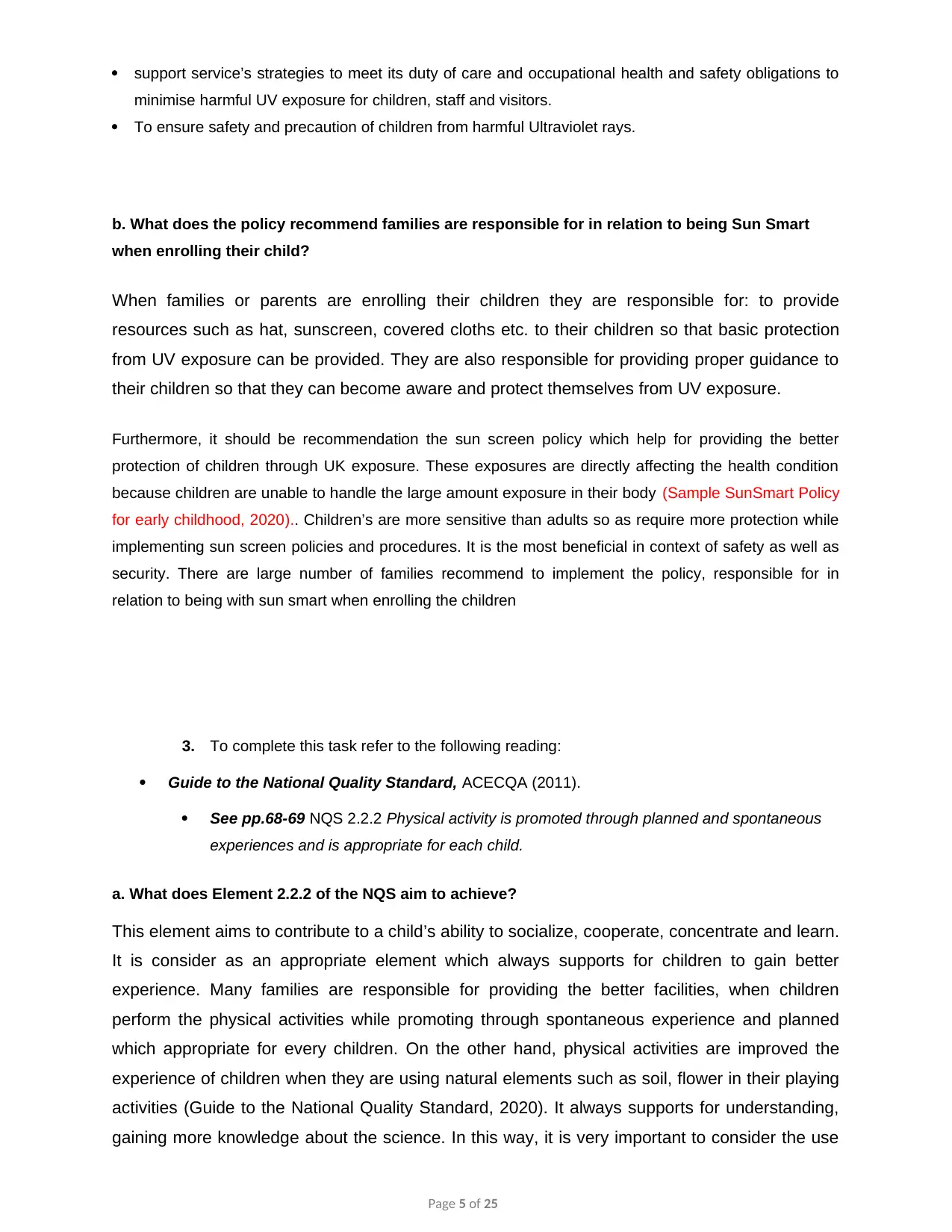
support service’s strategies to meet its duty of care and occupational health and safety obligations to
minimise harmful UV exposure for children, staff and visitors.
To ensure safety and precaution of children from harmful Ultraviolet rays.
b. What does the policy recommend families are responsible for in relation to being Sun Smart
when enrolling their child?
When families or parents are enrolling their children they are responsible for: to provide
resources such as hat, sunscreen, covered cloths etc. to their children so that basic protection
from UV exposure can be provided. They are also responsible for providing proper guidance to
their children so that they can become aware and protect themselves from UV exposure.
Furthermore, it should be recommendation the sun screen policy which help for providing the better
protection of children through UK exposure. These exposures are directly affecting the health condition
because children are unable to handle the large amount exposure in their body (Sample SunSmart Policy
for early childhood, 2020).. Children’s are more sensitive than adults so as require more protection while
implementing sun screen policies and procedures. It is the most beneficial in context of safety as well as
security. There are large number of families recommend to implement the policy, responsible for in
relation to being with sun smart when enrolling the children
3. To complete this task refer to the following reading:
Guide to the National Quality Standard, ACECQA (2011).
See pp.68-69 NQS 2.2.2 Physical activity is promoted through planned and spontaneous
experiences and is appropriate for each child.
a. What does Element 2.2.2 of the NQS aim to achieve?
This element aims to contribute to a child’s ability to socialize, cooperate, concentrate and learn.
It is consider as an appropriate element which always supports for children to gain better
experience. Many families are responsible for providing the better facilities, when children
perform the physical activities while promoting through spontaneous experience and planned
which appropriate for every children. On the other hand, physical activities are improved the
experience of children when they are using natural elements such as soil, flower in their playing
activities (Guide to the National Quality Standard, 2020). It always supports for understanding,
gaining more knowledge about the science. In this way, it is very important to consider the use
Page 5 of 25
minimise harmful UV exposure for children, staff and visitors.
To ensure safety and precaution of children from harmful Ultraviolet rays.
b. What does the policy recommend families are responsible for in relation to being Sun Smart
when enrolling their child?
When families or parents are enrolling their children they are responsible for: to provide
resources such as hat, sunscreen, covered cloths etc. to their children so that basic protection
from UV exposure can be provided. They are also responsible for providing proper guidance to
their children so that they can become aware and protect themselves from UV exposure.
Furthermore, it should be recommendation the sun screen policy which help for providing the better
protection of children through UK exposure. These exposures are directly affecting the health condition
because children are unable to handle the large amount exposure in their body (Sample SunSmart Policy
for early childhood, 2020).. Children’s are more sensitive than adults so as require more protection while
implementing sun screen policies and procedures. It is the most beneficial in context of safety as well as
security. There are large number of families recommend to implement the policy, responsible for in
relation to being with sun smart when enrolling the children
3. To complete this task refer to the following reading:
Guide to the National Quality Standard, ACECQA (2011).
See pp.68-69 NQS 2.2.2 Physical activity is promoted through planned and spontaneous
experiences and is appropriate for each child.
a. What does Element 2.2.2 of the NQS aim to achieve?
This element aims to contribute to a child’s ability to socialize, cooperate, concentrate and learn.
It is consider as an appropriate element which always supports for children to gain better
experience. Many families are responsible for providing the better facilities, when children
perform the physical activities while promoting through spontaneous experience and planned
which appropriate for every children. On the other hand, physical activities are improved the
experience of children when they are using natural elements such as soil, flower in their playing
activities (Guide to the National Quality Standard, 2020). It always supports for understanding,
gaining more knowledge about the science. In this way, it is very important to consider the use
Page 5 of 25
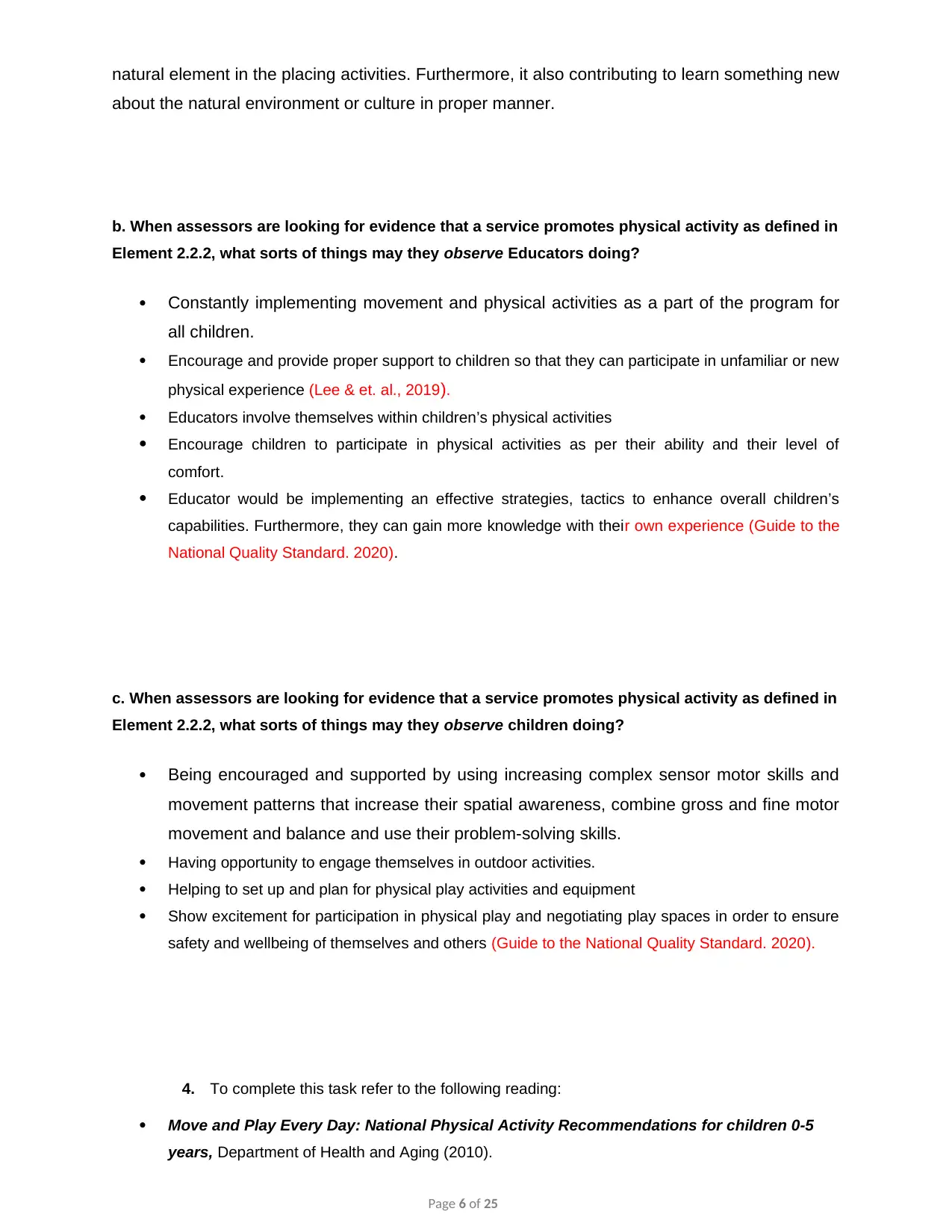
natural element in the placing activities. Furthermore, it also contributing to learn something new
about the natural environment or culture in proper manner.
b. When assessors are looking for evidence that a service promotes physical activity as defined in
Element 2.2.2, what sorts of things may they observe Educators doing?
Constantly implementing movement and physical activities as a part of the program for
all children.
Encourage and provide proper support to children so that they can participate in unfamiliar or new
physical experience (Lee & et. al., 2019).
Educators involve themselves within children’s physical activities
Encourage children to participate in physical activities as per their ability and their level of
comfort.
Educator would be implementing an effective strategies, tactics to enhance overall children’s
capabilities. Furthermore, they can gain more knowledge with their own experience (Guide to the
National Quality Standard. 2020).
c. When assessors are looking for evidence that a service promotes physical activity as defined in
Element 2.2.2, what sorts of things may they observe children doing?
Being encouraged and supported by using increasing complex sensor motor skills and
movement patterns that increase their spatial awareness, combine gross and fine motor
movement and balance and use their problem-solving skills.
Having opportunity to engage themselves in outdoor activities.
Helping to set up and plan for physical play activities and equipment
Show excitement for participation in physical play and negotiating play spaces in order to ensure
safety and wellbeing of themselves and others (Guide to the National Quality Standard. 2020).
4. To complete this task refer to the following reading:
Move and Play Every Day: National Physical Activity Recommendations for children 0-5
years, Department of Health and Aging (2010).
Page 6 of 25
about the natural environment or culture in proper manner.
b. When assessors are looking for evidence that a service promotes physical activity as defined in
Element 2.2.2, what sorts of things may they observe Educators doing?
Constantly implementing movement and physical activities as a part of the program for
all children.
Encourage and provide proper support to children so that they can participate in unfamiliar or new
physical experience (Lee & et. al., 2019).
Educators involve themselves within children’s physical activities
Encourage children to participate in physical activities as per their ability and their level of
comfort.
Educator would be implementing an effective strategies, tactics to enhance overall children’s
capabilities. Furthermore, they can gain more knowledge with their own experience (Guide to the
National Quality Standard. 2020).
c. When assessors are looking for evidence that a service promotes physical activity as defined in
Element 2.2.2, what sorts of things may they observe children doing?
Being encouraged and supported by using increasing complex sensor motor skills and
movement patterns that increase their spatial awareness, combine gross and fine motor
movement and balance and use their problem-solving skills.
Having opportunity to engage themselves in outdoor activities.
Helping to set up and plan for physical play activities and equipment
Show excitement for participation in physical play and negotiating play spaces in order to ensure
safety and wellbeing of themselves and others (Guide to the National Quality Standard. 2020).
4. To complete this task refer to the following reading:
Move and Play Every Day: National Physical Activity Recommendations for children 0-5
years, Department of Health and Aging (2010).
Page 6 of 25
⊘ This is a preview!⊘
Do you want full access?
Subscribe today to unlock all pages.

Trusted by 1+ million students worldwide
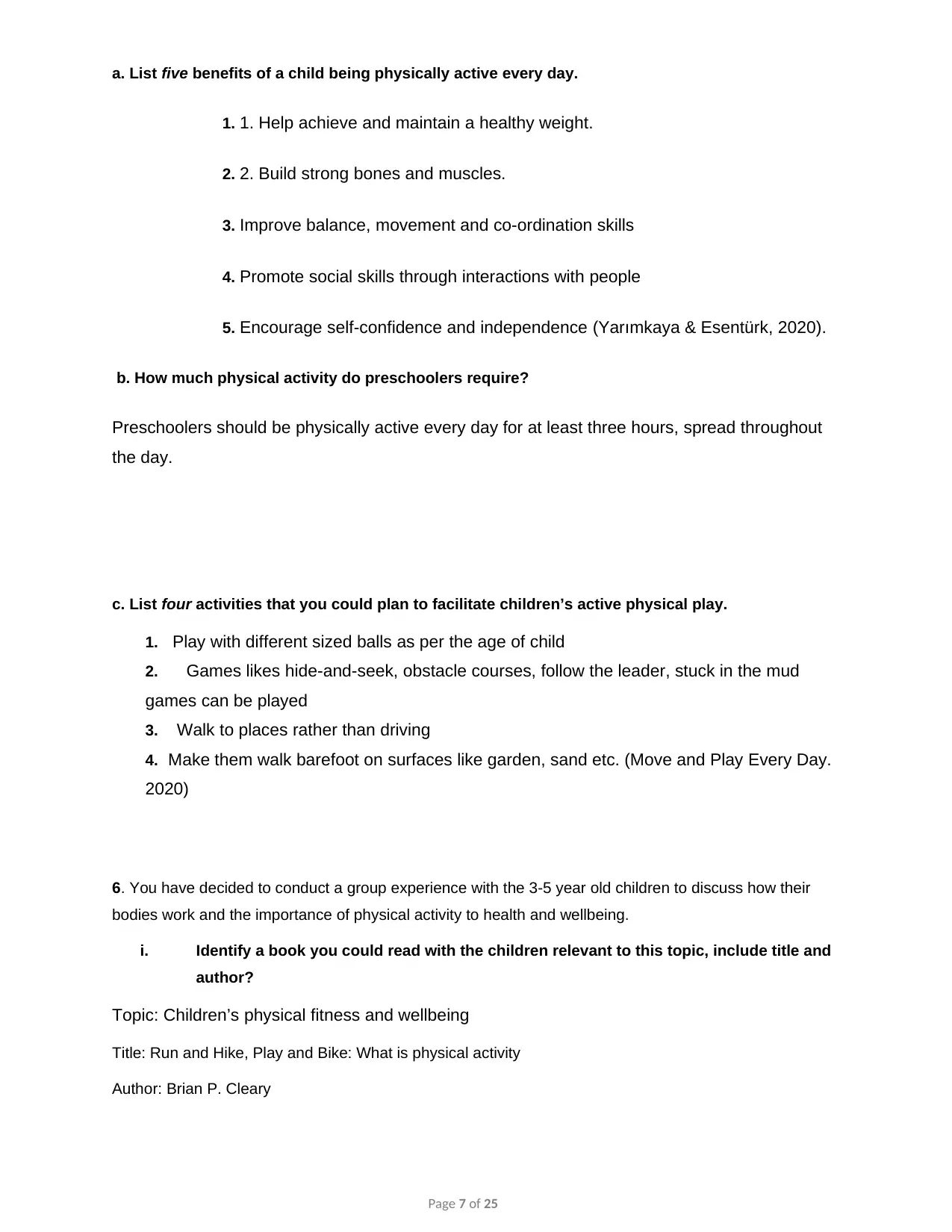
a. List five benefits of a child being physically active every day.
1. 1. Help achieve and maintain a healthy weight.
2. 2. Build strong bones and muscles.
3. Improve balance, movement and co-ordination skills
4. Promote social skills through interactions with people
5. Encourage self-confidence and independence (Yarımkaya & Esentürk, 2020).
b. How much physical activity do preschoolers require?
Preschoolers should be physically active every day for at least three hours, spread throughout
the day.
c. List four activities that you could plan to facilitate children’s active physical play.
1. Play with different sized balls as per the age of child
2. Games likes hide-and-seek, obstacle courses, follow the leader, stuck in the mud
games can be played
3. Walk to places rather than driving
4. Make them walk barefoot on surfaces like garden, sand etc. (Move and Play Every Day.
2020)
6. You have decided to conduct a group experience with the 3-5 year old children to discuss how their
bodies work and the importance of physical activity to health and wellbeing.
i. Identify a book you could read with the children relevant to this topic, include title and
author?
Topic: Children’s physical fitness and wellbeing
Title: Run and Hike, Play and Bike: What is physical activity
Author: Brian P. Cleary
Page 7 of 25
1. 1. Help achieve and maintain a healthy weight.
2. 2. Build strong bones and muscles.
3. Improve balance, movement and co-ordination skills
4. Promote social skills through interactions with people
5. Encourage self-confidence and independence (Yarımkaya & Esentürk, 2020).
b. How much physical activity do preschoolers require?
Preschoolers should be physically active every day for at least three hours, spread throughout
the day.
c. List four activities that you could plan to facilitate children’s active physical play.
1. Play with different sized balls as per the age of child
2. Games likes hide-and-seek, obstacle courses, follow the leader, stuck in the mud
games can be played
3. Walk to places rather than driving
4. Make them walk barefoot on surfaces like garden, sand etc. (Move and Play Every Day.
2020)
6. You have decided to conduct a group experience with the 3-5 year old children to discuss how their
bodies work and the importance of physical activity to health and wellbeing.
i. Identify a book you could read with the children relevant to this topic, include title and
author?
Topic: Children’s physical fitness and wellbeing
Title: Run and Hike, Play and Bike: What is physical activity
Author: Brian P. Cleary
Page 7 of 25
Paraphrase This Document
Need a fresh take? Get an instant paraphrase of this document with our AI Paraphraser
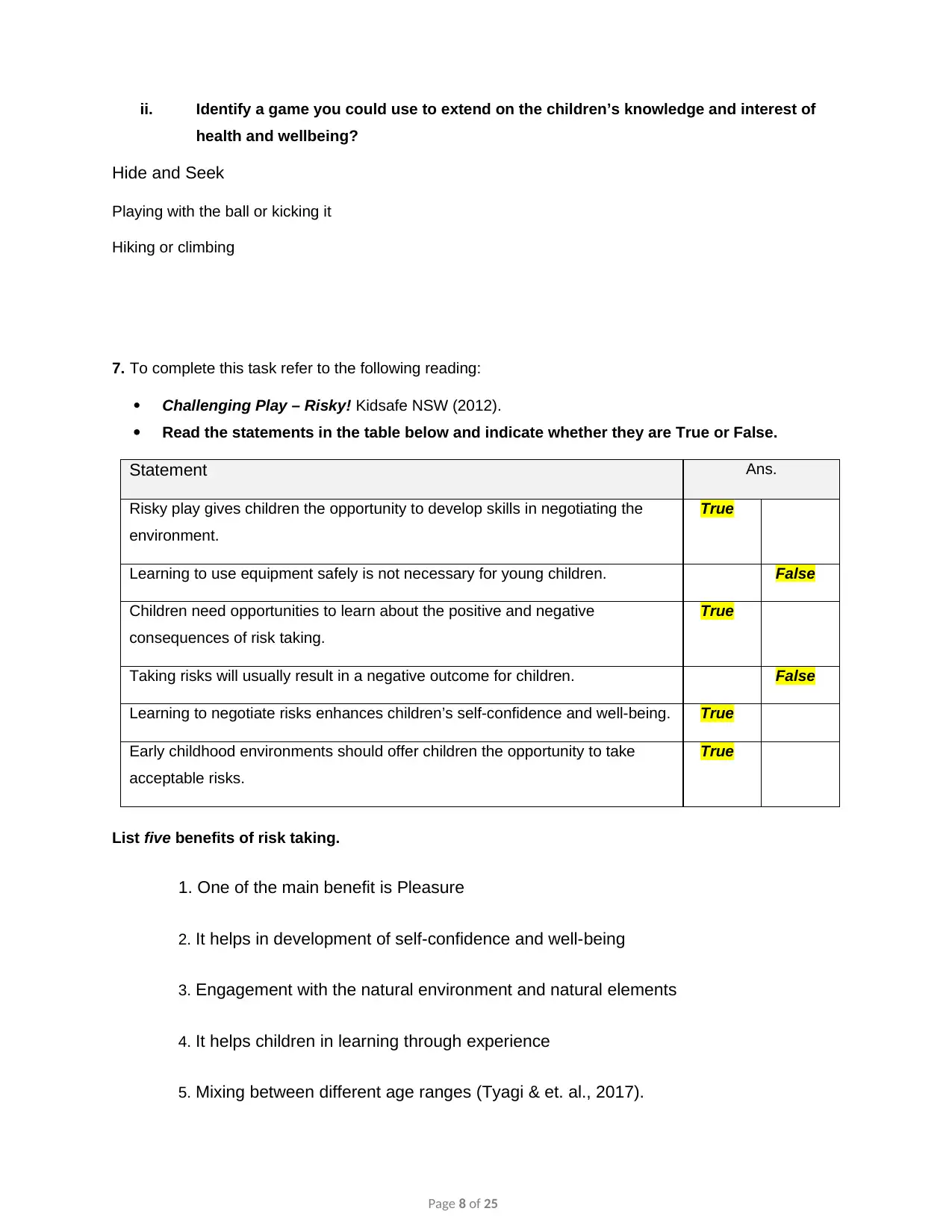
ii. Identify a game you could use to extend on the children’s knowledge and interest of
health and wellbeing?
Hide and Seek
Playing with the ball or kicking it
Hiking or climbing
7. To complete this task refer to the following reading:
Challenging Play – Risky! Kidsafe NSW (2012).
Read the statements in the table below and indicate whether they are True or False.
Statement Ans.
Risky play gives children the opportunity to develop skills in negotiating the
environment.
True
Learning to use equipment safely is not necessary for young children. False
Children need opportunities to learn about the positive and negative
consequences of risk taking.
True
Taking risks will usually result in a negative outcome for children. False
Learning to negotiate risks enhances children’s self-confidence and well-being. True
Early childhood environments should offer children the opportunity to take
acceptable risks.
True
List five benefits of risk taking.
1. One of the main benefit is Pleasure
2. It helps in development of self-confidence and well-being
3. Engagement with the natural environment and natural elements
4. It helps children in learning through experience
5. Mixing between different age ranges (Tyagi & et. al., 2017).
Page 8 of 25
health and wellbeing?
Hide and Seek
Playing with the ball or kicking it
Hiking or climbing
7. To complete this task refer to the following reading:
Challenging Play – Risky! Kidsafe NSW (2012).
Read the statements in the table below and indicate whether they are True or False.
Statement Ans.
Risky play gives children the opportunity to develop skills in negotiating the
environment.
True
Learning to use equipment safely is not necessary for young children. False
Children need opportunities to learn about the positive and negative
consequences of risk taking.
True
Taking risks will usually result in a negative outcome for children. False
Learning to negotiate risks enhances children’s self-confidence and well-being. True
Early childhood environments should offer children the opportunity to take
acceptable risks.
True
List five benefits of risk taking.
1. One of the main benefit is Pleasure
2. It helps in development of self-confidence and well-being
3. Engagement with the natural environment and natural elements
4. It helps children in learning through experience
5. Mixing between different age ranges (Tyagi & et. al., 2017).
Page 8 of 25
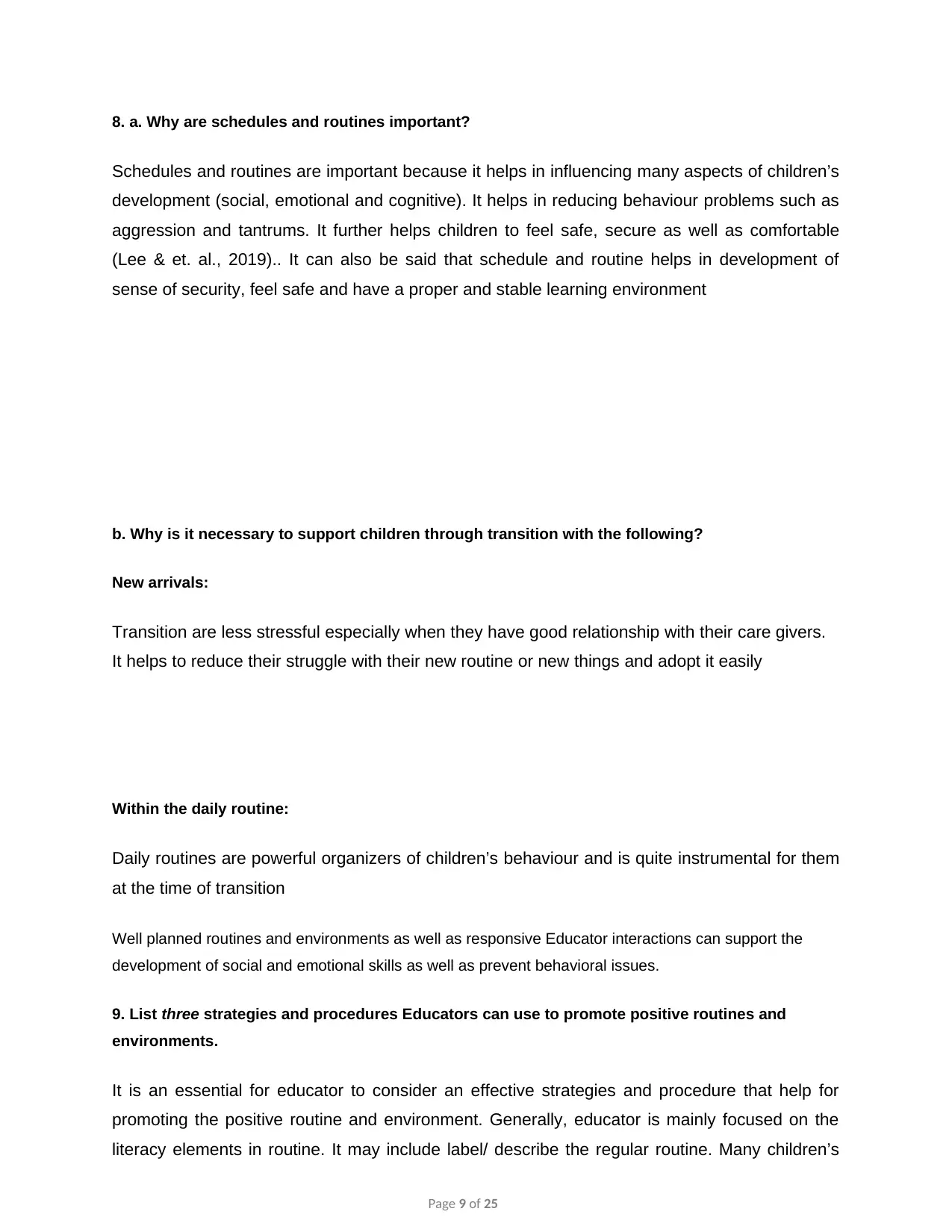
8. a. Why are schedules and routines important?
Schedules and routines are important because it helps in influencing many aspects of children’s
development (social, emotional and cognitive). It helps in reducing behaviour problems such as
aggression and tantrums. It further helps children to feel safe, secure as well as comfortable
(Lee & et. al., 2019).. It can also be said that schedule and routine helps in development of
sense of security, feel safe and have a proper and stable learning environment
b. Why is it necessary to support children through transition with the following?
New arrivals:
Transition are less stressful especially when they have good relationship with their care givers.
It helps to reduce their struggle with their new routine or new things and adopt it easily
Within the daily routine:
Daily routines are powerful organizers of children’s behaviour and is quite instrumental for them
at the time of transition
Well planned routines and environments as well as responsive Educator interactions can support the
development of social and emotional skills as well as prevent behavioral issues.
9. List three strategies and procedures Educators can use to promote positive routines and
environments.
It is an essential for educator to consider an effective strategies and procedure that help for
promoting the positive routine and environment. Generally, educator is mainly focused on the
literacy elements in routine. It may include label/ describe the regular routine. Many children’s
Page 9 of 25
Schedules and routines are important because it helps in influencing many aspects of children’s
development (social, emotional and cognitive). It helps in reducing behaviour problems such as
aggression and tantrums. It further helps children to feel safe, secure as well as comfortable
(Lee & et. al., 2019).. It can also be said that schedule and routine helps in development of
sense of security, feel safe and have a proper and stable learning environment
b. Why is it necessary to support children through transition with the following?
New arrivals:
Transition are less stressful especially when they have good relationship with their care givers.
It helps to reduce their struggle with their new routine or new things and adopt it easily
Within the daily routine:
Daily routines are powerful organizers of children’s behaviour and is quite instrumental for them
at the time of transition
Well planned routines and environments as well as responsive Educator interactions can support the
development of social and emotional skills as well as prevent behavioral issues.
9. List three strategies and procedures Educators can use to promote positive routines and
environments.
It is an essential for educator to consider an effective strategies and procedure that help for
promoting the positive routine and environment. Generally, educator is mainly focused on the
literacy elements in routine. It may include label/ describe the regular routine. Many children’s
Page 9 of 25
⊘ This is a preview!⊘
Do you want full access?
Subscribe today to unlock all pages.

Trusted by 1+ million students worldwide
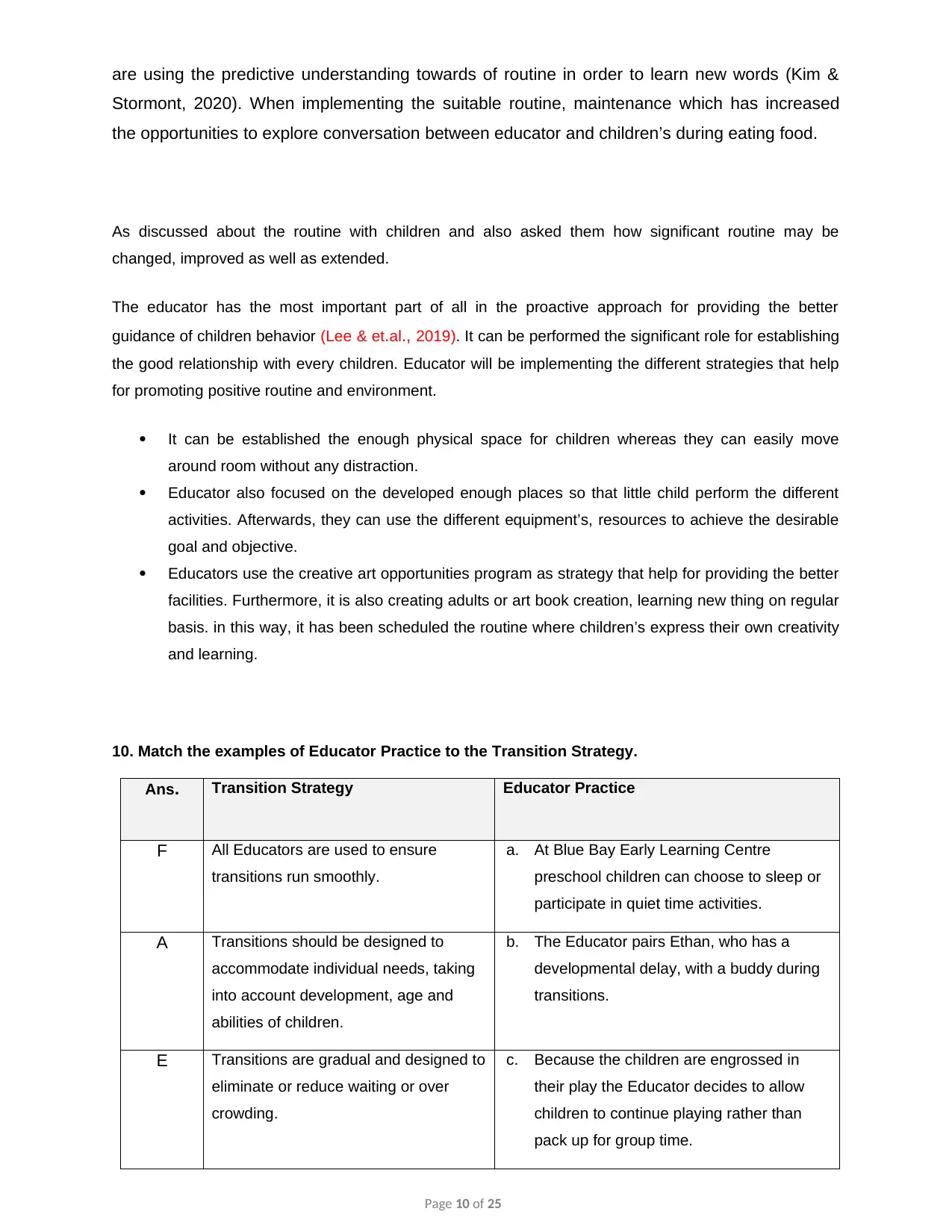
are using the predictive understanding towards of routine in order to learn new words (Kim &
Stormont, 2020). When implementing the suitable routine, maintenance which has increased
the opportunities to explore conversation between educator and children’s during eating food.
As discussed about the routine with children and also asked them how significant routine may be
changed, improved as well as extended.
The educator has the most important part of all in the proactive approach for providing the better
guidance of children behavior (Lee & et.al., 2019). It can be performed the significant role for establishing
the good relationship with every children. Educator will be implementing the different strategies that help
for promoting positive routine and environment.
It can be established the enough physical space for children whereas they can easily move
around room without any distraction.
Educator also focused on the developed enough places so that little child perform the different
activities. Afterwards, they can use the different equipment’s, resources to achieve the desirable
goal and objective.
Educators use the creative art opportunities program as strategy that help for providing the better
facilities. Furthermore, it is also creating adults or art book creation, learning new thing on regular
basis. in this way, it has been scheduled the routine where children’s express their own creativity
and learning.
10. Match the examples of Educator Practice to the Transition Strategy.
Ans. Transition Strategy Educator Practice
F All Educators are used to ensure
transitions run smoothly.
a. At Blue Bay Early Learning Centre
preschool children can choose to sleep or
participate in quiet time activities.
A Transitions should be designed to
accommodate individual needs, taking
into account development, age and
abilities of children.
b. The Educator pairs Ethan, who has a
developmental delay, with a buddy during
transitions.
E Transitions are gradual and designed to
eliminate or reduce waiting or over
crowding.
c. Because the children are engrossed in
their play the Educator decides to allow
children to continue playing rather than
pack up for group time.
Page 10 of 25
Stormont, 2020). When implementing the suitable routine, maintenance which has increased
the opportunities to explore conversation between educator and children’s during eating food.
As discussed about the routine with children and also asked them how significant routine may be
changed, improved as well as extended.
The educator has the most important part of all in the proactive approach for providing the better
guidance of children behavior (Lee & et.al., 2019). It can be performed the significant role for establishing
the good relationship with every children. Educator will be implementing the different strategies that help
for promoting positive routine and environment.
It can be established the enough physical space for children whereas they can easily move
around room without any distraction.
Educator also focused on the developed enough places so that little child perform the different
activities. Afterwards, they can use the different equipment’s, resources to achieve the desirable
goal and objective.
Educators use the creative art opportunities program as strategy that help for providing the better
facilities. Furthermore, it is also creating adults or art book creation, learning new thing on regular
basis. in this way, it has been scheduled the routine where children’s express their own creativity
and learning.
10. Match the examples of Educator Practice to the Transition Strategy.
Ans. Transition Strategy Educator Practice
F All Educators are used to ensure
transitions run smoothly.
a. At Blue Bay Early Learning Centre
preschool children can choose to sleep or
participate in quiet time activities.
A Transitions should be designed to
accommodate individual needs, taking
into account development, age and
abilities of children.
b. The Educator pairs Ethan, who has a
developmental delay, with a buddy during
transitions.
E Transitions are gradual and designed to
eliminate or reduce waiting or over
crowding.
c. Because the children are engrossed in
their play the Educator decides to allow
children to continue playing rather than
pack up for group time.
Page 10 of 25
Paraphrase This Document
Need a fresh take? Get an instant paraphrase of this document with our AI Paraphraser
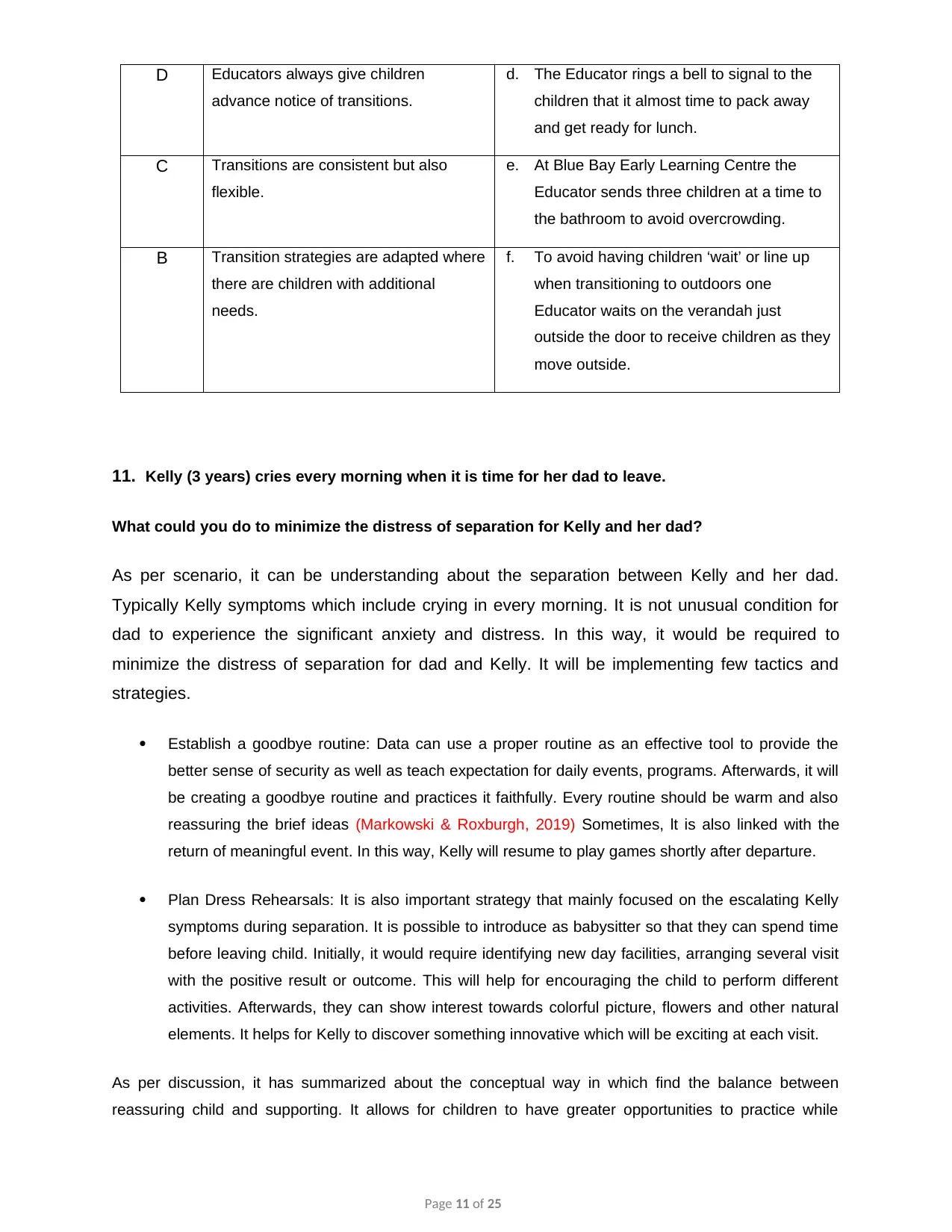
D Educators always give children
advance notice of transitions.
d. The Educator rings a bell to signal to the
children that it almost time to pack away
and get ready for lunch.
C Transitions are consistent but also
flexible.
e. At Blue Bay Early Learning Centre the
Educator sends three children at a time to
the bathroom to avoid overcrowding.
B Transition strategies are adapted where
there are children with additional
needs.
f. To avoid having children ‘wait’ or line up
when transitioning to outdoors one
Educator waits on the verandah just
outside the door to receive children as they
move outside.
11. Kelly (3 years) cries every morning when it is time for her dad to leave.
What could you do to minimize the distress of separation for Kelly and her dad?
As per scenario, it can be understanding about the separation between Kelly and her dad.
Typically Kelly symptoms which include crying in every morning. It is not unusual condition for
dad to experience the significant anxiety and distress. In this way, it would be required to
minimize the distress of separation for dad and Kelly. It will be implementing few tactics and
strategies.
Establish a goodbye routine: Data can use a proper routine as an effective tool to provide the
better sense of security as well as teach expectation for daily events, programs. Afterwards, it will
be creating a goodbye routine and practices it faithfully. Every routine should be warm and also
reassuring the brief ideas (Markowski & Roxburgh, 2019) Sometimes, lt is also linked with the
return of meaningful event. In this way, Kelly will resume to play games shortly after departure.
Plan Dress Rehearsals: It is also important strategy that mainly focused on the escalating Kelly
symptoms during separation. It is possible to introduce as babysitter so that they can spend time
before leaving child. Initially, it would require identifying new day facilities, arranging several visit
with the positive result or outcome. This will help for encouraging the child to perform different
activities. Afterwards, they can show interest towards colorful picture, flowers and other natural
elements. It helps for Kelly to discover something innovative which will be exciting at each visit.
As per discussion, it has summarized about the conceptual way in which find the balance between
reassuring child and supporting. It allows for children to have greater opportunities to practice while
Page 11 of 25
advance notice of transitions.
d. The Educator rings a bell to signal to the
children that it almost time to pack away
and get ready for lunch.
C Transitions are consistent but also
flexible.
e. At Blue Bay Early Learning Centre the
Educator sends three children at a time to
the bathroom to avoid overcrowding.
B Transition strategies are adapted where
there are children with additional
needs.
f. To avoid having children ‘wait’ or line up
when transitioning to outdoors one
Educator waits on the verandah just
outside the door to receive children as they
move outside.
11. Kelly (3 years) cries every morning when it is time for her dad to leave.
What could you do to minimize the distress of separation for Kelly and her dad?
As per scenario, it can be understanding about the separation between Kelly and her dad.
Typically Kelly symptoms which include crying in every morning. It is not unusual condition for
dad to experience the significant anxiety and distress. In this way, it would be required to
minimize the distress of separation for dad and Kelly. It will be implementing few tactics and
strategies.
Establish a goodbye routine: Data can use a proper routine as an effective tool to provide the
better sense of security as well as teach expectation for daily events, programs. Afterwards, it will
be creating a goodbye routine and practices it faithfully. Every routine should be warm and also
reassuring the brief ideas (Markowski & Roxburgh, 2019) Sometimes, lt is also linked with the
return of meaningful event. In this way, Kelly will resume to play games shortly after departure.
Plan Dress Rehearsals: It is also important strategy that mainly focused on the escalating Kelly
symptoms during separation. It is possible to introduce as babysitter so that they can spend time
before leaving child. Initially, it would require identifying new day facilities, arranging several visit
with the positive result or outcome. This will help for encouraging the child to perform different
activities. Afterwards, they can show interest towards colorful picture, flowers and other natural
elements. It helps for Kelly to discover something innovative which will be exciting at each visit.
As per discussion, it has summarized about the conceptual way in which find the balance between
reassuring child and supporting. It allows for children to have greater opportunities to practice while
Page 11 of 25

managing the emotions. Therefore, it provides the facilities of their children from their fears, it can help to
manage the distress during separation.
Page 12 of 25
manage the distress during separation.
Page 12 of 25
⊘ This is a preview!⊘
Do you want full access?
Subscribe today to unlock all pages.

Trusted by 1+ million students worldwide
1 out of 25
Related Documents
Your All-in-One AI-Powered Toolkit for Academic Success.
+13062052269
info@desklib.com
Available 24*7 on WhatsApp / Email
![[object Object]](/_next/static/media/star-bottom.7253800d.svg)
Unlock your academic potential
Copyright © 2020–2025 A2Z Services. All Rights Reserved. Developed and managed by ZUCOL.





